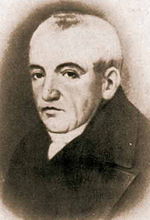Petru Maior

Petru Maior (Romanian pronunciation:
Works
Petru Maior took a stand and responded, in 1812, by writing the "History of the Beginnings of the Romanians in Dacia" against all those who questioned the origin, character, and the becoming of his people.[2]
Among his works are
- "Didahii" (1809),
- "Propovedanii" (1809),
- "Prediche" (Sermons) (1810–1811)
- "Istoria pentru începutul românilor în Dachia" (History of the beginnings of the Romanians in Dacia) (1812)
- "Istoria Besearicei românilor" (History of Romanian Church) (1813).
He was a prolific writer, who published everything he wrote during his lifetime except for two theological works: "Procanon" (1783) and "Protopopadichia" (The power of the archpriests) (1795).[3]
The Buda Lexicon, a book published in 1825, included two texts by Petru Maior, Orthographia romana sive latino-valachica una cum clavi and Dialogu pentru inceputul linbei române, in which he introduced the letters ș for /ʃ/ and ț for /ts/, which have since been in use in the Romanian alphabet.[4]
Among the ideas vehiculated by him was that before the Council of Florence Romanians used the Latin alphabet to write.[5]
References
- ^ Laura Stanciu, "Transylvanian Review. Vol. XXX, No.2: Petru Maior, the Transylvanian School Influencer ", (2021), pp. 3-18.
- ^ Laura Stanciu, "Transylvanian Review. Vol. XXX, No.2: Petru Maior, the Transylvanian School Influencer ", (2021), pp. 3-18.
- ^ Laura Stanciu, "Transylvanian Review. Vol. XXX, No.2: Petru Maior, the Transylvanian School Influencer ", (2021), pp. 3-18.
- ^ Marinella Lörinczi Angioni, "Coscienza nazionale romanza e ortografia: il romeno tra alfabeto cirillico e alfabeto latino ", La Ricerca Folklorica, No. 5, La scrittura: funzioni e ideologie. (Apr., 1982), pp. 75–85.
- ISBN 9789027234582.
Further reading
